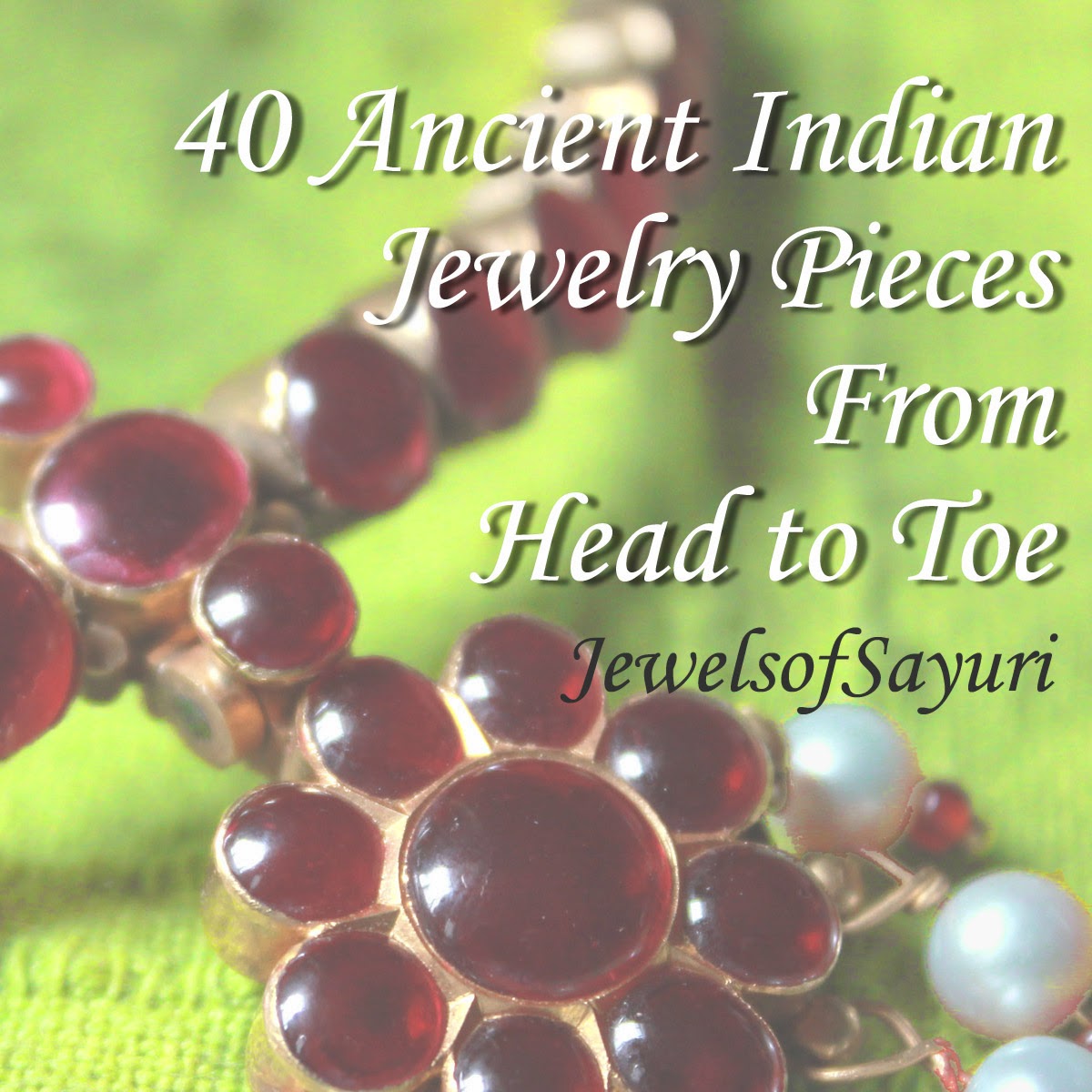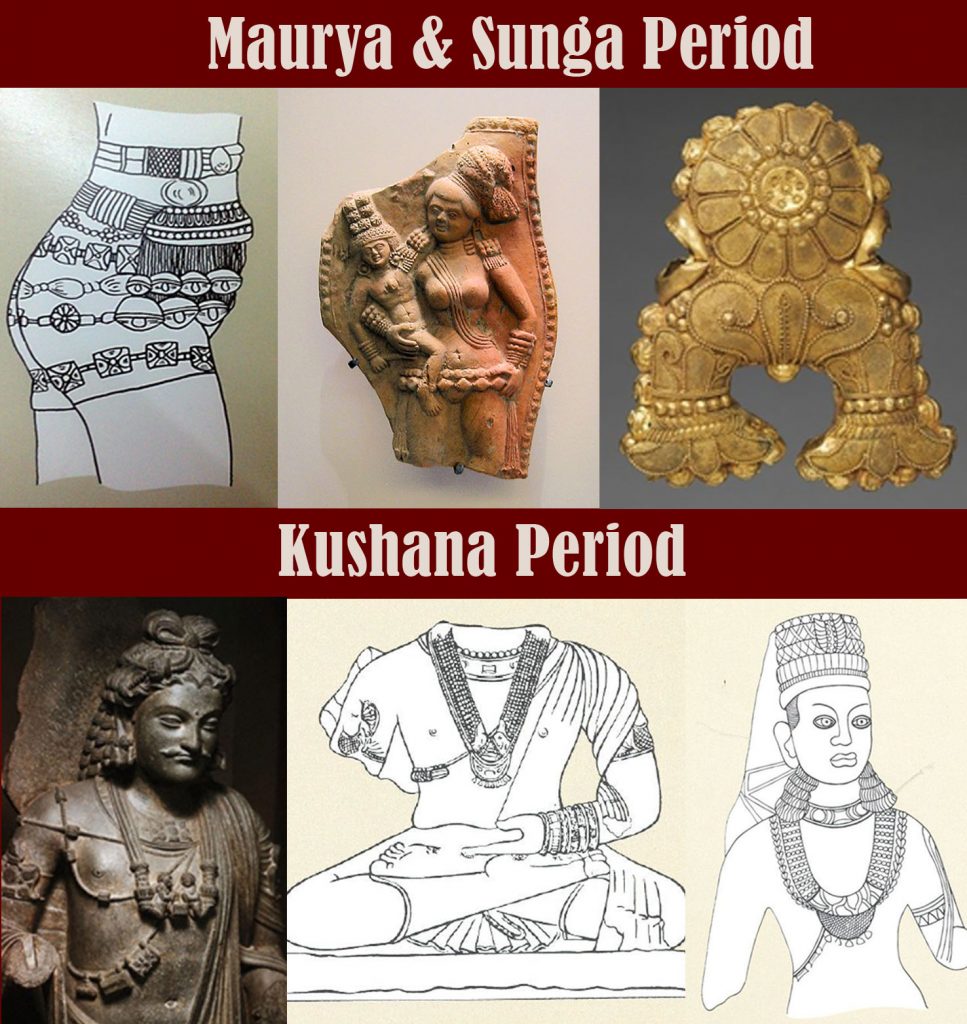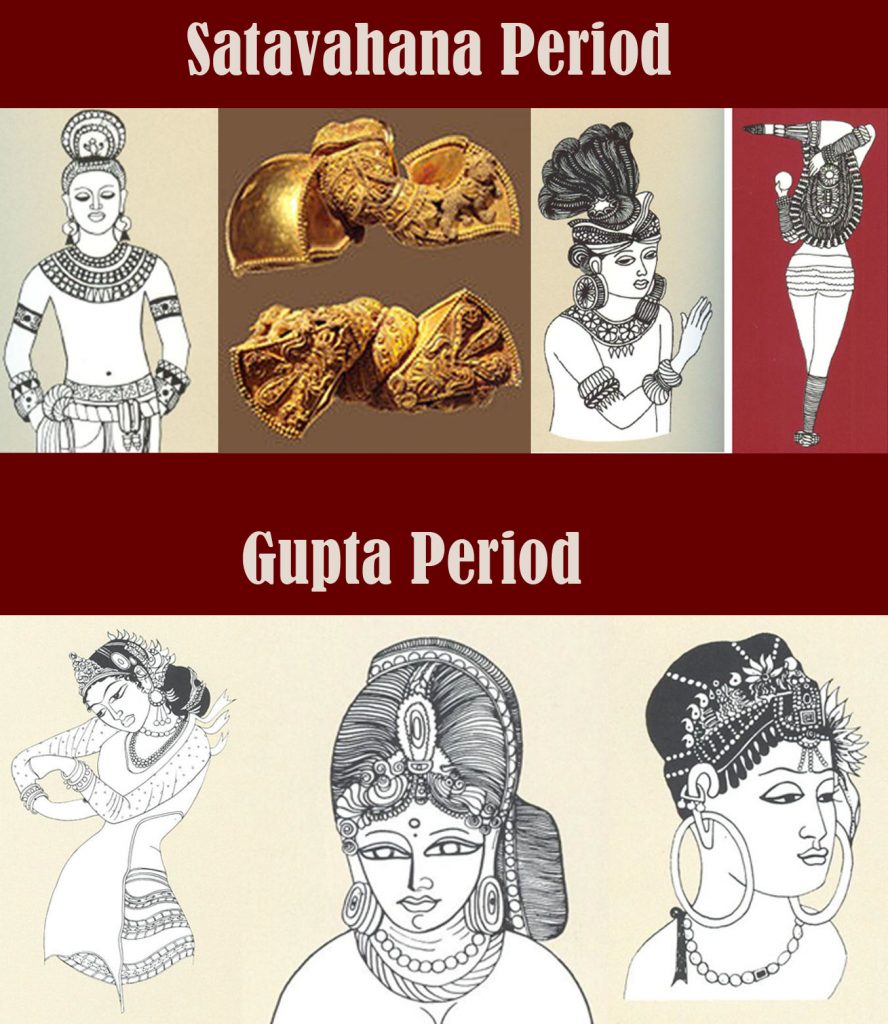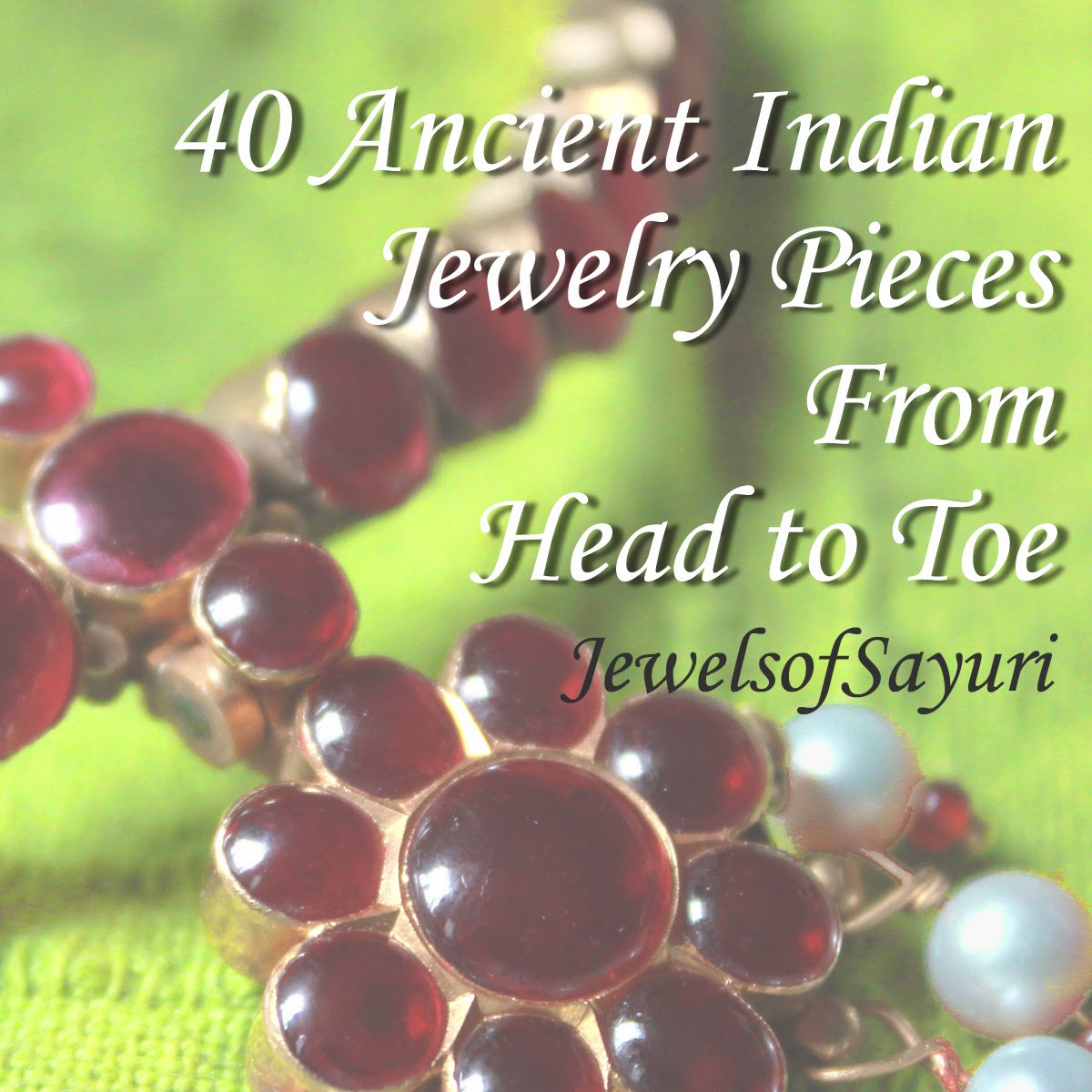Here is a list of Ancient Indian Jewellery (from Vedic period – to Gupta period) worn in each part of the body starting from the head. Please add to the list you find something missing. Many of these are in use even now and some disappeared in the following periods and made an emergence after a few centuries. A few like the sitara, bindi have been included as a societal norm in the passage of time. These Ornaments have not only been worn by women but also by men (especially royalty) as seen from ancient sculptures, paintings and frescoes.

List of Ancient Indian Jewellery from Head to toe
Most of these objects are denoted by their Sanskrit names in this post. However, they exist in some variation or other across India and are known by their local names in regional language.
Jewellery worn on the Head and Forehead
- Mukuta/ Kirita : a decorative tiara or crown
- Sirsajala – hairnet, Muktajala – pearl hair net
- Ratnajali : from the elaborate tiara-like ornament around the head, strands of pearls form a net over the hair-style; there is a central ornament at the forehead from which are suspended strands of pearls.
- Opasa : a simple fillet or headband
- Mauli – Decorative turban (not actually considered jewelry)
- Chudamani : lotus-shaped, its petals composed of pearls and precious stones. It was worn at teh back of the head in the centre of the knotted hair.
- Sitara: Star shaped ornament of gold or silver with a stamped pattern, with or without the Bina. Worn below the parting of the hair and at the center of the forehead
- Makarika : fish-crocodile shaped and worn at the front parting of the hair
- Tilaka – drawn floral motif – not jewellery but adornment. Bindi may be a descendant. Bindi- a dot traditional made with kunkum or sindoor
Jewellery worn on the Ears
- Karnika – earrings
- Karnaphul -Trumpet-shaped (Flower Shaped)
- Dehri – disc Shaped
- Circle or Ring – Kundala
- Karnika – Jimki/ Jumkha (shape of lotus seed-pod fixed upside down like a tassel). Often Karnaphul was generically called Karnika. In the later periods the karnaphul was dominated by ornamental rosettes and the kundala with wire work and beads.
- Bali: small earrings with suspended pearls; worn higher up on the ear
- Kila – ear tops/studs
Jewellery worn on the Neck and chest
- Torque: twisted wire necklace of Celtic origin
- Kantha : Short necklace of beads (usually heavy and flat)
- Lambanam: long necklace of beads worn between the breasts – sometimes with amulet boxes. Both Kantha & lambanam ranges from being 3 stringed to seven stringed – usually made with gold/silver beads or pearls. A Lambanam or Hara (later shortened to haar) could be – Tilari – 3 stringed, Chaulari– 4 stringed, Paklari– 5 stringed, Satlari– 7 stringed
- Phalaka: three or five slab-like gems, inserted at regular intervals to hold together the several strings of which a necklace was composed, and whole was called a phalakahara.
- Yashti :A necklace of gems and gold beads
- Nishka : Coin necklace
- Ratnamalika – small gem studded necklace while Ratnavali is a grand gem set necklace.
- Mukatavali: necklace of one strand of small pearls. Suddha Ekavali : a single strand pearl necklace with a gem at the centre; has ribbon ties
- Sutra: chain for the neck. When made of gold with precious stones in the centre, it was called hemasutra (led to the MangalSutra meaning holy chain)
- Vijayantika : necklace of strings of looped pearls with precious stones
- Vaikaksha: two long strings of pearls crossed at the chest
- Atkan : bead necklace worn aslant over the left shoulder and under the right arm(akin to the sacred thread)
- Yajnopavita : sacred thread
- Triveni – breast ornament

Jewellery worn on the Hands
- Baju Band/ Keyura: armlet with simple or elaborate patterns. Keyura has clasps while the baju band is a tie-up.
- Angada or Ananta: Coiled snake like armlet worn above the keyura.
- Kangan: bracelets of beads on each wrist (thick usually 3 – 5 strings).
- Valaya : bangles of glass, shell, or ivory sometimes with claps worn at wrist
- Anguliya/Angulika : ring. Variations include mudraanguliyaka which is a signet ring and Ratnanguliya, a ring with gemstones.
Jewellery worn on the Waist/ Hip
- Kanchi – singke strand girdle
- Mekala: Multi stringed (8+) beaded hip belt (originally made from red seed kaksha & then from gold/silver). Rasana has 16 strands of beads while kalapa has 25.
- Kulaka – a net of pearls for the hip.

Jewellery worn on the Legs
- Thigh- Pada-patra – Garter like ornament worn at the thigh.
- Kinkini : anklet with its small bells (Similar to Ghunghru of present times).
- Nupura: simple cylindrical anklet – Maninupura – anklet made from jewelled beads.
- Sankla : anklets made of thick chains
- Kara : Anklets of twisted wire worn on both ankles
- Manjira : hollow and light, coiling several times around the ankles loosely, and tinkling when in motion as it had gems inserted in the hollow. Similar to kataka or Silambu.
Materials used in Ancient Indian Jewellery
Apart from Gold (hiranya and suvarna), silver (Rajata) and copper (tamra), a lot of gemstones/ ratna were used in Ancient Indian Jewellery. Gemstones such as carnelian, agate, lapis lazuli, amethyst, garnet, coral, rubies, sapphires, topaz, diamonds, and cat’s eye were important. The Navaratna have talismanic properties. Pearls and beads of glass and metal were used.
Besides this, the art of enameling, granulation, and filigree were known, as well as inlay work in shell and mother-of-pearl. Gold beads were filigreed or filled with lac, while others had cores of jasper and turquoise paste and were strung on thread or wire to be worn as necklaces. Ivory was used extensively to make combs, brooches, hairpins, boxes and other objects. More often than not Embroidery took the place of jewels for its vibrancy and light weight
This concludes my two part series on Ancient Indian Jewellery.
References
- Bharata-muni. “Chapter XXIII – Costumes and Make-up (nepathya).” Natya Shastra. Wisdom Library. October 06, 2017.
- Ancient Indian Costume by Roshen Alkazi
I hope you Find it interesting
Cheers




Leave a Reply